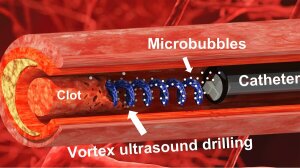'Ultrasonic tornado' technique breaks down brain blood clots in under half an hour
by
John R. Fischer, Senior Reporter | February 03, 2023

Vortex ultrasound breaks down blood clots in the brain in less than half an hour, reducing the risk for hemmorhages.
In a collaborative project, scientists across the U.S. have developed a new solution that can break down blood clots in the brain quicker than traditional methods, using a technique called vortex ultrasound.
Described as an "ultrasonic tornado", Vortex ultrasound enables the ultrasound to swirl as it moves forward, creating ultrasound waves with helical wavefronts that destroy clots faster with the shear stress they create, according to the authors’ paper, A Model of High-Speed Endovascular Sonothrombolysis with Vortex Ultrasound-Induced Shear Stress to Treat Cerebral Venous Sinus Thrombosis.
The solution is made up of a single transducer specifically designed to produce the swirling, vortex effect, and small enough to be incorporated into a catheter. The catheter is fed through the circulatory system to the site of the blood clot.
Traditional approaches largely rely on dissolving cerebral venous sinus thrombosis (CVST). In their research, the authors found that pharmaceutical interventions like this took at least 15 hours to dissolve clots and an average of around 29 hours. Vortex ultrasound dissolved an acute blood clot in under half an hour.
“The fact that our new technique works quickly is important, because CVST clots increase pressure on blood vessels in the brain. This increases the risk of a hemorrhage in the brain, which can be catastrophic for patients,” said Chengzhi Shi, co-corresponding author of the work and an assistant professor of mechanical engineering at Georgia Tech, in a statement.
The researchers assessed the tool and method via in vitro testing, using cow blood in a 3D-printed model of the cerebral venous sinus.
Because any catheterization or surgical intervention can potentially damage blood vessels or inflict other harm, the researchers studied this risk in vortex ultrasound when applied to animal blood vein samples, but found no damage to the walls of the blood vessels. They also found no substantial damage to red blood cells.
Because conventional treatments for CVST fail in 20%-40% of cases, the researchers plan to assess the viability of the technique in an animal model. Should it be successful, they then hope to pursue clinical trials.
“And if the vortex ultrasound ever becomes a clinical application, it would likely be comparable in cost to other interventions used to treat CVST,” says Shi.
The study was published in the open-access journal, Research, a Science Partner Journal.
|
|
|
You Must Be Logged In To Post A Comment
|
